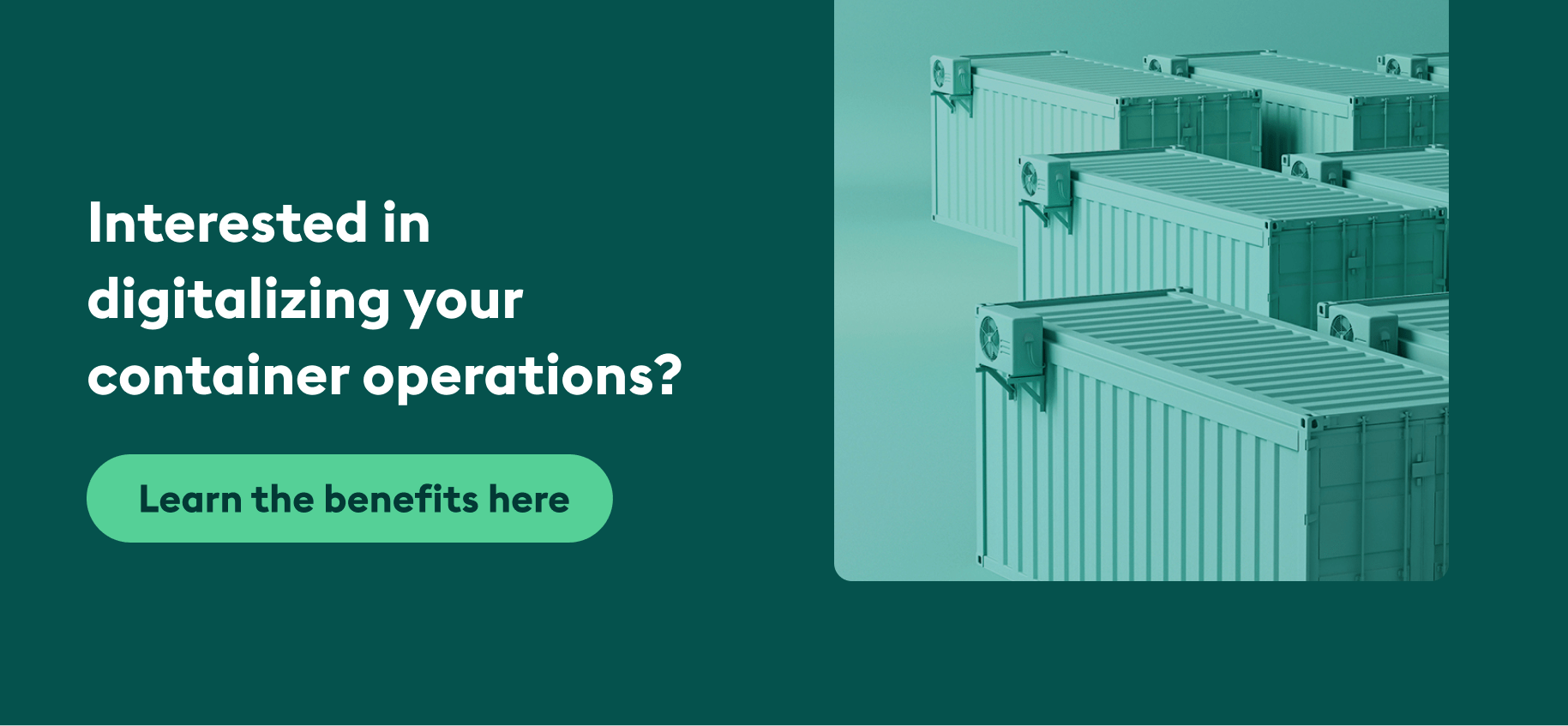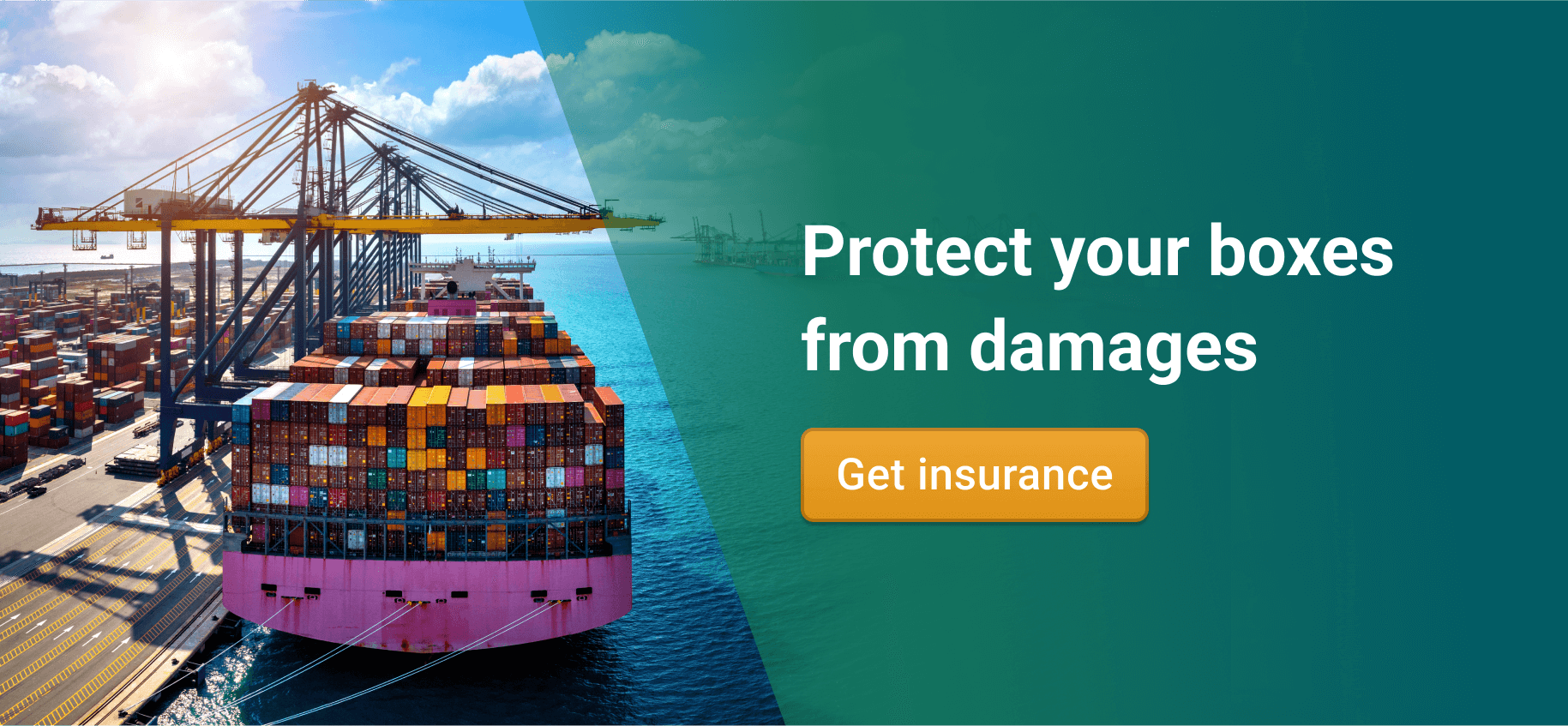Last updated: 24 October, 2023
Container damage is unavoidable and can happen at any stage of shipping. Read this blog to discover different types of damage and how you can avoid it. Find out why surveys and insurance are the best ways to protect your containers against expensive damages.
Container damages are the Catch-22 of the shipping business. No matter how much you try to avoid it, even the sturdiest boxes get damaged during shipping. Barring the small wear-and-tears, damage to boxes can become a huge financial loss for both owners and users.
But did you know that not all damages are inevitable? Several kinds of container damage — often caused by human errors — can be avoided. Proper stowing and handling of containers can reduce these expensive losses by a great margin.
And for unavoidable damages, you can always prepare in advance with container insurance. We’ll see how insurance can save you from time-consuming disputes and expensive repairs further in this blog. Or you can skip it and learn it directly from our experts on container insurance.
Click on the banner below to know how you can safeguard your containers against damages and where you can find the right insurance plan for your needs.
What is container damage?
Container damage happens when the structural integrity of a container is compromised. It’s essentially a broad term used for a range of damages. From a minor dent on the container wall to containers getting lost at sea, anything can be categorized as container damage.
But what’s important to note is that your container’s integrity impacts your cargo’s condition. In most cases, container damage leads to cargo damage. According to the UK P&I club, almost 11% of the total cargo damage claims filed in a year are due to the containers getting lost overboard. Not only this is a huge financial risk but is likely to embroil you in a painfully complicated claims process and disputes.
Unfortunately, damages — whether small or substantial — are common.
How often do containers get damaged?
According to Freightwaves, “One out of four containers that pass through the US ports gets damaged at some interchange points”. The damage could be the result of natural disasters, human error, or machine malfunctions.
Usually, the first human error is the wrong choice of container for your cargo. Something that can also impact how well you can stuff your cargo and avoid freight damages. And these damages are 100% avoidable. Read this blog to learn about and choose the right kind of container type for your cargo.
Once you have the right container, it needs to be surveyed for previous damages, odors, holes, ventilation, cleanliness, temperature control, and proper flooring. Let’s now look at what causes container damage.
Main reasons for container damage
It’s difficult to pin down what exactly causes container damage. Shipping is a complicated process with multiple steps. From loading, trucking, and shipping, to unloading, the containers exchange multiple hands and eventually get mishandled along the way. Yet, there are a few common reasons for container damage.
Bad stowing
Bad stowing is one of the biggest reasons for physical damage to the container. Overloading the container, uneven distribution of the weight, tying up the cargo in a loose manner, or insufficient use of dunnage can cause the cargo to sway during transport. This results from the lack of supervision of the shippers, lack of knowledge in cargo stowing, and trying to save costs without understanding the consequences.
Bad weather
The next influential factor in container damage is the weather. Weather is unpredictable and causes internal and external damage. The air near the ocean has high levels of moisture and when they get trapped in the container, they settle in the colder areas. When the container goes to a hotter region, the moisture condenses into water and climbs onto the walls and the ceiling, and starts to drip down causing ‘container rain’. This results in rusting and corrosion of the container walls.
Contamination of containers
Containers can be deemed unworthy to use because of contamination. They could be contaminated with pests or sometimes odor. For instance, a container that previously carried food items can pass on the odor to the next cargo item such as clothing.
Mishandling during loading & unloading
Container damages also happen while loading and unloading. Inexperienced fork lifters can cause punctures, and dents, stack them unevenly or drop containers. If the dents or punctures haven’t caused extensive damage they can be patched up. Because of the damage, containers sustain during transit and shipping, the boxes have to be inspected on a regular basis. One of the things that are checked, is the maximum load stacking capacity before it starts warping. That’s also called the container racking test.
Types of container damage & how to avoid
As you’ve seen, physical damage to a container can happen at every transit point. This also impacts the container conditions, which impacts what a container costs and what it can be used for. Below you can see a list of the most common damages and some prevention tips:
Broken container doors
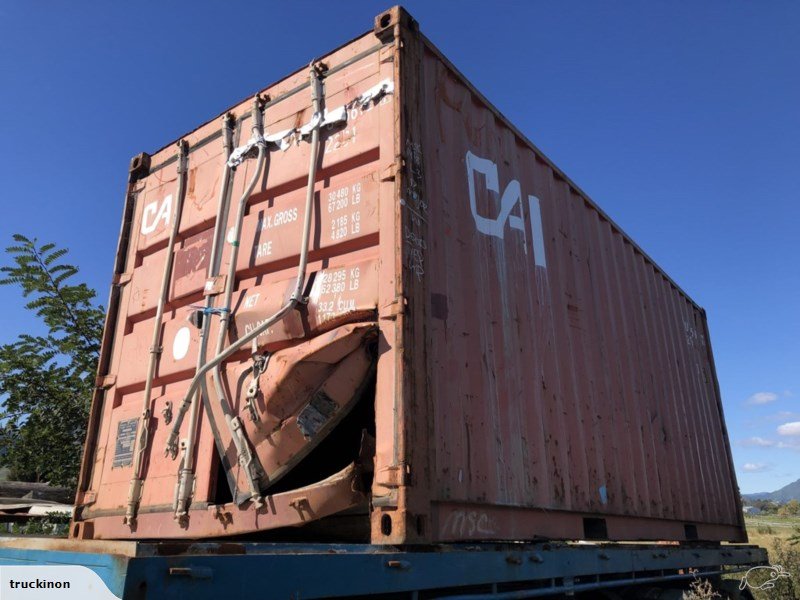
This can happen due to the poor handling of containers or careless securing while loading, leading to major dents, buckling and damage to door mechanisms.
Container doors can also be broken by thieves trying to force them open to steal goods. Here, container seals may be damaged as well.
Besides damage to the doors and container seals, door seals can also be affected by the above situations, meaning that the doors can no longer keep rain and wind out.
Tip: The container frames, seals and structure should be checked at the terminal. Repair if possible, otherwise notify the shipper before the dispatch.
Total loss of shipping containers
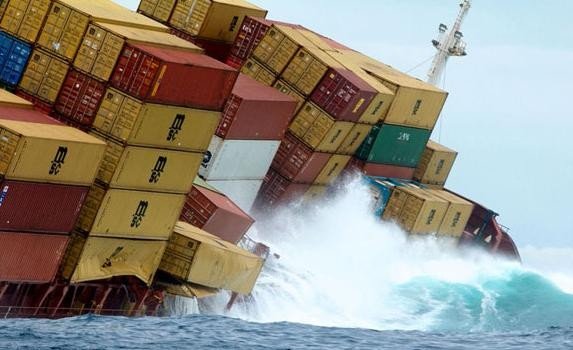
This can be caused by swaying in bad weather, poor stacking of containers, wrongly declared weights, or bad stowing techniques.
Tip: The crew needs to act on weather-related warnings, steer clear from storms, follow colregs to avoid a collision, the lashing needs to be done properly, check the condition of lashing regularly.
Dented and scratched containers
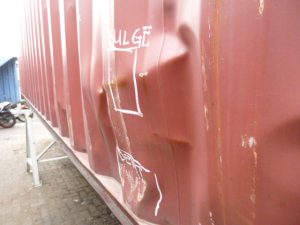
Dents and scratches can occur due to the poor handling of the containers by forklifts, if containers scrape against each other during transport, or in road accidents. There are different degrees of dents and scratches, some being superficial, while others are more serious and require container repairs. Major dents can affect the evenness of the inner container walls, while large scratches can cause rusting on the container body.
Tip: Check the frames and walls at the dispatch points, educate the drivers and crane operators on proper handling.
Dropped shipping containers
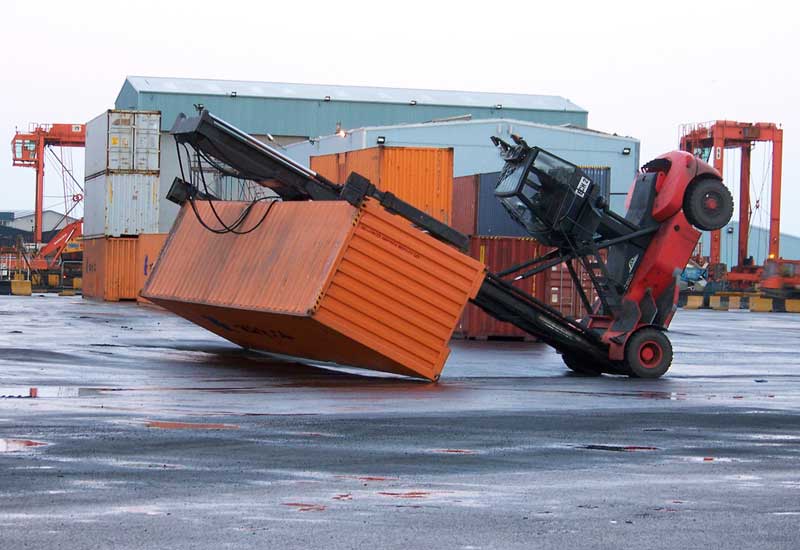
Shipping containers can be dropped if a forklift is faulty, a container is overloaded or unbalanced, or handling is not done properly.
This can lead to serious damage on the container body and structure including dents, buckling and holes. If a container is dropped from a significant height, repairs are likely to be extremely costly. Sometimes, a container may even be damaged beyond repair.
Tip: Check for container casting conditions, stack container symmetrically, and do not overload containers.
Heat damage
Due to wrongly declared goods on containers, fires can sometimes start on board or even within a container. This can damage both the container itself, as well as the goods inside.
Tip: Comply with IMDG Code regulations for segregation/heat sources, avoid storing near heated region.
Holes in the container body
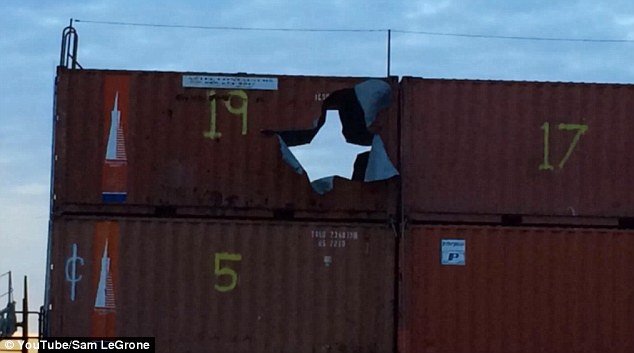
Holes can form in container walls, floors and ceilings. Containers can be punctured due to poor handling of forklifts, or if they’re hit by a vehicle or another container. Large holes need to be repaired as quickly as possible, otherwise water, wind and moisture can enter the container and damage goods.
Tip: Set a container maintenance schedule, regularly inspect your containers for corrosion, wear and tear.
Container damage: Road accidents

Containers can be damaged due to bad weather, poor road conditions, bad stowage and driver fatigue. Toppled or dropped containers may have major body damage, as well as dents, scratches and holes.
Tip: Road haulers need to be professional on the road, check for proper stowage.
Container damage: Train derailment
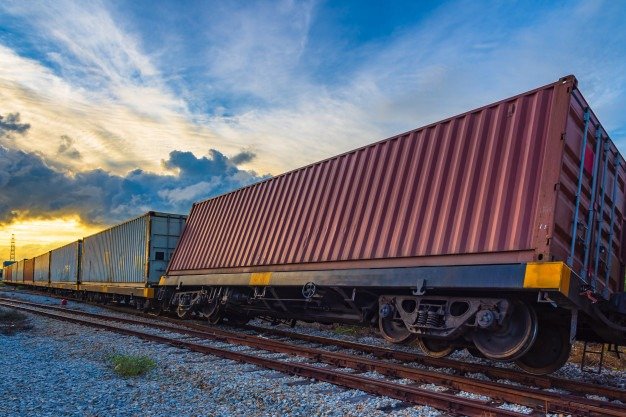
Derailment can happen due to excessive speed limits, bad railway tracks, bad weather or driver fatigue. Once again, this can lead to major container body damage, dents, scratches and holes.
Tip: Check for optimum driving conditions.
As we’ve just seen, containers go through a lot when they make a trip around the world. That’s why containers and equipment are inspected before or after a company lease a container. Want to know more about these inspections? Read all about them and the container surveyors here.
Who is responsible for container damage?
We’ve seen that containers can get damaged at any point in the loading, unloading, and transportation process. Therefore, the responsibility for container damage can be really subjective. It depends on how and where the damage was incurred.
However, the main question (and the answer for which you’re looking) is ‘who is liable for container damage?’. The costs of container damage can vary with every incident and cannot be predetermined. The container users and owners are usually the disputing parties. And the damages are compensated by either of them after the necessary evidence is collected. Unless resolved amicably, the users and owners wait for survey reports to resolve the matter.
Most companies agree on a damage-protection plan (DPP) for minor damage (costs below $100) to make sure the maintenance and repair are worth it. But the liability for damages often falls on users. This is because DPP is often too small to cover the extent of these damages. And then, the user pays for damages from their pocket.
Well, this may be unfair, but there’s a way. And it depends on your preparedness and proactiveness. Let’s look at how you can save money on container damages.
What to do when containers get damaged
When your container arrives damaged, you have to take all the steps to note down the details of the damage. These details will help you during the claim process. Based on the cases we deal with at Container xChange we have collected some information on what happens when there is a damaged container.
How to deal with a damaged container
- The user of the container is always recommended to take pictures of the container on the off chance that the container gets damaged.
- Once the container is returned to the depot, the owner gets a surveyor to check the condition of the container to assess the damages.
- The depot then creates photographic evidence of the damages and creates an invoice. If the value falls under the quoted amount of the Damage Protection Plan agreed by both parties, then the supplier takes care of the damage.
- In case, the value is higher, the invoice is then sent to the user of the container. The user has 30 days to pay from the day he receives the invoice. If the user doesn’t agree with the charges, he has 10 days to start a dispute.
- At this point, both parties can conduct a joint survey with two surveyors representing each side or one surveyor, with whom they both agree. The charges are then paid based on the result of the survey.
- In case of a total loss of the container, the user of the container must compensate for the container, and it cannot be disputed.
- But each case of container damage can be different, and solutions are given on a case-by-case basis. These disputes can last anywhere between 2 days to weeks based on the intensity of the dispute.
But each case of container damage can be different, and solutions are given on a case-by-case basis. These disputes can last anywhere between 2 days to weeks based on the intensity of the dispute.
Wondering how container surveys can come in handy in such situations? Let’s find out.
How container survey reduces container damages and claims
Once the container survey report arrives, the users and the owners will get an objective idea of the damages. And the extent of repair needed. This way, the user will only have to pay for what’s actually required. Such off-hire surveys help in the fast resolution of such damage disputes.
But you can reduce container damages altogether with surveys. In fact, container surveys aren’t something you should do only after container damage. Container owners should keep getting their containers surveyed to know about timely maintenance and repairs. This way, owners can ensure the good seaworthy condition of their containers. This will reduce damages and eventually these claims.
In fact, container users should also get the containers surveyed before they lease containers from owners. When you get the container surveyed beforehand, you’ll have a clear picture of the container’s damages and condition pre-journey. You can use these on-hire surveys to protect yourself from any fraud and unnecessary payments.
On Container xChange, you can book both these surveys in just simple steps. Our members can simply click on the ‘Request Survey’ button and connect with surveyors in 4000+ locations. Our extensive network of expert surveyors will inspect your containers at a nominal price. Interested to know more? Click on the banner below and get answers to all your queries.
How container insurance saves money on container damages and repairs
On the other hand, you can take precautions and get container insurance. As you must have seen, container damages are hard to predict. And can quickly become an expensive affair!
The best way to save money on such hefty expenses is by booking container insurance. Once you have booked the right container insurance, you won’t be liable to pay for these damages and repairs out of your pocket. Your insurance will cover these expenses.
Considering how often containers get damaged, opting for container insurance is one of the best financial decisions you’ll make in the shipping industry.
Interested in understanding what insurance plans suit you the best? Let’s find out.
Choose the perfect container insurance plan for you
On Container xChange, our members can safeguard themselves with a DPP and two container insurance policies. We enable our members to file for damage claims and process these till their resolution.
Damage Protection Plan
A damage protection plan (DPP) will help you compensate for container maintenance and repair. The supplier pays for DPP, and only covers repairs up to a certain cost. It’s useful when you don’t want to make damage assessments every time you lease out a container.
Total Loss Insurance
Total loss insurance, also known as Basic Insurance, will protect your containers from total loss. The policy covers constructive total loss, general average, and mysterious disappearance. The insurance is valid for one-way moves up to 60 days from the pick-up date. It’ll automatically renew if the container isn’t returned within the insurance term.
Container Damage Insurance
Container Damage insurance, also called Premium Insurance, will protect your containers from total loss and all other kinds of container damage. Containers can get damaged in many ways. This policy gives you coverage for such damages that occur during one-way moves up to 60 days from the pick-up date. It’ll automatically renew if the container isn’t returned within the insurance term.
Protection for the entire fleet with the Insurance Manager
With our Insurance Manager feature, you can ensure even the containers that are not present on xChange. It’s a super convenient way of insuring your entire fleet at a competitive price. Plus, you get full support from our team in the damage claim process.
Our insurance plans are tailored according to the needs of all members. Whether you are just looking for damage protection or want coverage for all containers, you can trust xChange to get fair deals. So stop worrying about container damages and prepare for smooth sailing.
Interested in knowing our insurance prices? Or do you want to get complete know-how on different surveys? Click on the banner below to talk to our experts. They’ll show you how you can book container insurance and surveys in just a few clicks.
Container Damage: Common FAQs
What are the different types of cargo damages?
There are various kinds of cargo damages such as wet damage, physical damage, contamination, infestation, and reefer related damage among others.
What is container damage?
Container damage happens when the structural integrity of a container is compromised. It’s essentially a broad term used for a range of damages. From a minor dent on the container wall to containers getting lost at sea, anything can be categorized as container damage.
Who is responsible for shipping container damage?
The responsibility for container damage can be really subjective. It depends on how and where the damage was incurred. But container users and owners are usually the parties responsible for damage liability.



